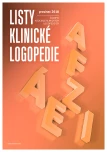Some notes on bilingualism in aphasia
Authors:
Mgr. Flanderková Eva, Ph.D.
Authors‘ workplace:
Adresa posledního pracoviště (do 31. 7. 2018): Technische Universität Dortmund, Institut für deutsche Sprache und Literatur, Emil-Figge-Str. 50, D-44227 Dortmund
Published in:
Listy klinické logopedie 2018; 2(2): 8-12
Category:
Main topic
Overview
The article deals with bilingualism in aphasia. First, several questions concerning bilingualism are outlined whereas some of the general standards of bilingual research are mentioned. Second, the particular research on language organization in bilingual mind/brain is given some attention. The third section of the arcticle addresses the spontaneous recovery from bilingual aphasia, sections four and five discuss bilingual aphasia assessment and therapy. The article concludes with a short summary.
Keywords:
bilingualism – aphasia – assessment of bilingual aphasia – therapy of bilingual aphasia – sign language
Sources
- ANSALDO, A. I. – SAIDI, L. G. (2014): Aphasia therapy in the age of globalization: Cross-linguistic therapy effects in bilingual aphasia. Behavioural Neurology, http://dx.doi.org/10.1155/2014/603085.
- DE BOT, K. (1992): The multilingual lexicon: Modeling selection and control. The International Journal of Multilingualism 1(1), s. 17–32.
- CHAMBERS, C. – COOK, H. (2009): Lexical competition during second-language listening: sentence context, but not proficiency, constraints interference from the native lexicon. Journal of Experimental Psychology: Learning, Memory, and Cognition 35(4), s. 1029–1040.
- FABBRO, F. (1999): The neurolinguistics of bilingualism. New York: Psychology Press.
- FABBRO, F. (2001): The bilingual brain: bilingual aphasia. Brain and Language 79, s. 201–210.
- FAROQI-SHAH, Y. – FRYMARK, T. – MULLEN, R. – WANG, B. (2010): Effect of treatment for bilingual individuals with aphasia: A systematic review of the evidence. Journal of Neurolinguistics 23, s. 319–341.
- FLANDERKOVÁ, E.: Čeština v afázii: teorie a empirie. V tisku.
- GORAL, M. – LEVY, E. – KASTL, R. (2010): Cross-language treatment generalisation: A case of trilingual aphasia. Aphasiology 24(2), s. 170–187.
- GROSJEAN, F. (1989): Neurolinguists, beware! The bilingual is not two monolinguals in one person. Brain and Language 36, s. 3–15.
- GROSJEAN, F. – LI, P. (2016): The psycholinguistics of bilingualism. Chichester – Mandel – Oxford: Wiley-Blackwell.
- JABŮREK, J. (1998): Bilingvální vzdělávání neslyšících. Praha: Septima.
- JUNCOS-RABADÁN, O. (2015): Bilingual aphasia. In: International encyclopedia of the social & behavioral sciences, 2. vyd., díl 2., Elsevier, s. 574–579.
- KHACHATRYAN, E. – VANHOOF, G. – BEYENS, H. – GOELEVEN, A. – THIJS, V. – VAN HULLE, M. M. (2016): Language processing in bilingual aphasia: a new insight into the problem. Wiley interdisciplinary reviews, Wires / Cognitive science 7/3, Malden, MA: Wiley-Blackwell, s. 180–196.
- KIRAN, S. – SANDBERG, Ch. – GRAY, T. – ASCENSO, E. – KESTER, E. (2013): Rehabilitation in bilingual aphasia: evidence for within- and between-language generalization. American Journal of Speech and Language Pathology 22, s. 298–309.
- LACHOUT, M. (2017): Bilingvismus a bilingvní výchova na příkladu bilingvismu česko-německého. Praha: Togga: Metropolitan University Prague Press.
- LEVELT, W. J. M. (2013): A history of psycholinguistics: The pre-Chomskyan era. Oxford: Oxford University Press.
- MERTINS, B. (2016): The use of experimental methods in linguistic research: advantages, problems and possible pitfalls. In: Anstatt, T. – Gattnar, A. – Clasmeier, Ch. (eds.): Slavic languages in psycholinguistics, Tübinger Beiträge zur Linguistik, 554, s. 15–33.
- MIERTSCH, B. – MEISEL, J. M. – ISEL, F. (2009): Non-treated languages in aphasia therapy of polyglots benefit from improvement in the treated language. Journal of Neurolinguistics 22, s. 135–150.
- PARADIS, M. (2004): A neurolinguistic theory of bilingualism. Amsterdam: J. Benjamins.
- SCHMIEDTOVÁ, B. – FLANDERKOVÁ, E. (2012): Neurolingvistika: předmět, historie, metody. Slovo a slovesnost 73, s. 46–62.
- SVOBODOVÁ, J. (2014): Bilingvismus a interference – slovanské jazyky. Plzeň: Západočeská univerzita.
- ŠTEFÁNIK, J. (2004). Antológia bilingvizmu. Bratislava: Academic Electronic Press.
- WEEKES, B. S. (2010): Issues in bilingual aphasia: An introduction. In: Aphasiology 24(2), s. 123–125.
Labels
Clinical speech therapy General practitioner for children and adolescentsArticle was published in
Clinical speech therapy (Listy klinické logopedie)

2018 Issue 2
- What Effect Can Be Expected from Limosilactobacillus reuteri in Mucositis and Peri-Implantitis?
- Hope Awakens with Early Diagnosis of Parkinson's Disease Based on Skin Odor
- Deep stimulation of the globus pallidus improved clinical symptoms in a patient with refractory parkinsonism and genetic mutation
- The Importance of Limosilactobacillus reuteri in Administration to Diabetics with Gingivitis
Most read in this issue
- Dostupné materiály pro terapii afázie v klinické praxi
- Acquired childhood aphasia
- Primary progressive aphasia
- Služby klientům s afázií
